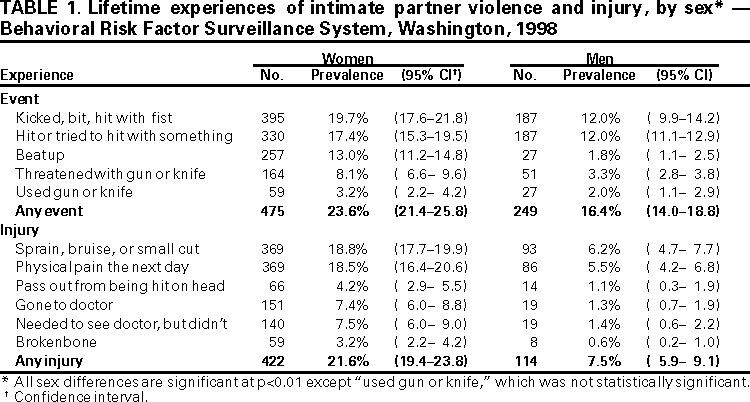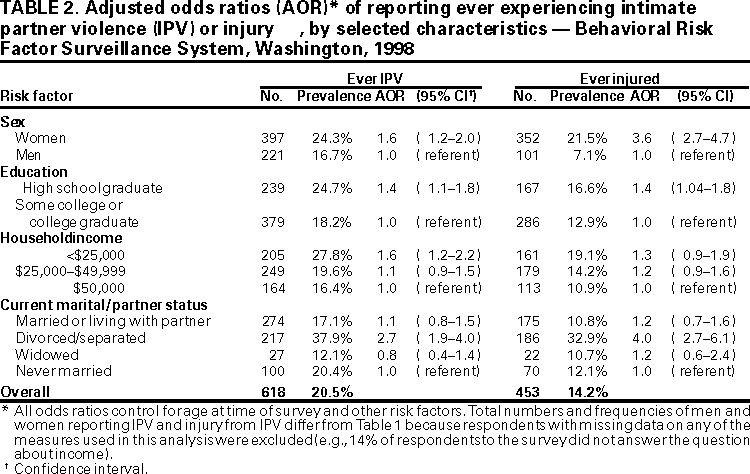 |
|
|
|
|
|
|
| ||||||||||
|
|
|
|
|
|
|
||||
| ||||||||||
|
|
|
|
|
Persons using assistive technology might not be able to fully access information in this file. For assistance, please send e-mail to: mmwrq@cdc.gov. Type 508 Accommodation and the title of the report in the subject line of e-mail. Prevalence of Intimate Partner Violence and Injuries --- Washington, 1998Approximately 20% of emergency department visits for trauma and 25% of homicides of women involve intimate partner violence (IPV) (1,2). To assess IPV prevalence in Washington, the Washington State Department of Health added questions from the Conflict Tactics Scale (3) and the Revised Conflict Tactics Scale (4) to its 1998 Behavioral Risk Factor Surveillance System (BRFSS) survey. This report describes an analysis of responses to the questions, which indicated that women were more likely than men to experience IPV in their lifetime, and more than three times more likely than men to experience injuries from IPV. BRFSS is an ongoing, state-based, random-digit--dialed telephone survey of the U.S. civilian, noninstitutionalized population aged >18 years that collects information about modifiable risk factors for chronic diseases and leading causes of death. In 1998, 3604 persons responded to the Washington BRFSS. Because the questions were considered sensitive, permission was asked before beginning the IPV section, and 3381 (93.5%) gave permission. Only English-speaking persons were respondents. The survey response rate was 61.4%. Respondents were asked whether they had experienced IPV during their lifetime (i.e., kicked, bit, or hit with fist; hit or tried to hit with something; beat up; threatened with gun or knife; or used gun or knife) and whether they had sustained physical injury (sprain, bruise, or small cut; physical pain the next day; passed out from being hit on head; went to doctor; needed to see doctor but didn't; or broken bone) resulting from IPV. An intimate partner was defined as a current or former spouse, live-in partner, boyfriend, girlfriend, or date. Some respondents might have referred to a same-sex partner; the sex of the partner was not asked. Responses were weighted for selection probability by the number of adults and telephone numbers in the household, and whether the number was drawn from a block of 100 numbers containing at least one or no listed number. Responses also were weighted to approximate the Washington population on the basis of the respondents' age and sex. In 1998, of approximately 2,113,000 women aged >18 who resided in Washington (5), approximately 499,000 (23.6%) (95% confidence interval [CI]=453,000--545,000) experienced IPV during their lives, and 456,000 (21.6%) women (95% CI=410,000--502,000) had a physical injury resulting from IPV. Of the 2,049,000 men (5), approximately 336,000 (16.4%) (95% CI=289,000--383,000) experienced IPV and approximately 154,000 (7.5%) (95% CI=121,000--187,000) experienced injury from IPV (Table 1). Multivariate logistic regressions were conducted to identify the levels of lifetime risk associated with sex, education, income, and marital status. Odds ratios (ORs) for education, income, and marital status were similar for men and women; therefore, data for both sexes were combined (Table 2). Compared with never married status, divorced/separated status was associated with an almost three-fold increase in the risk for reported IPV (OR=2.7; 95% CI=1.9--4.0) and a four-fold increase in the risk for injury from IPV (OR=4.0; 95% CI=2.7--6.1); 45.3% of divorced/separated women reported an injury from an intimate partner. Low education level also was associated with increased risk for IPV (OR=1.4; 95% CI=1.1--1.8) and injury from IPV (OR=1.4; 95% CI=1.04--1.8). Low income level was associated with increased risk for IPV (OR=1.6; 95% CI=1.2--2.2); however, the association between low income and injury from IPV was not significant (OR=1.3; 95% CI=0.9--1.9). Reported by: L Bensley, PhD, S Macdonald, PhD, J Van Eenwyk, PhD, Acting State Epidemiologist, Office of Epidemiology; K Wynkoop Simmons, PhD, D Ruggles, MBA, Washington State Dept of Health. Family and Intimate Violence Prevention Team, Div of Violence Prevention, National Center for Injury Prevention and Control, CDC. Editorial Note:This report indicates that IPV in Washington is more prevalent among women than men. Other studies have found that women have similar or higher IPV rates than men but that women are more likely to sustain injury (3,6--8). Although low education and income levels are risk factors for reported IPV, 17.6% of women with incomes of >$50,000 per year and 20.2% of women with at least some college education reported injuries as a result of IPV. In addition, divorced/separated respondents were more likely to report violence than married, widowed, or never married respondents. The findings in this report are subject to at least three limitations. First, the study was limited by its dependence on self-reports, which might be inaccurate because of recall bias or unwillingness to report. Second, this study did not include persons without telephones or persons who did not speak English. Third, because of their cross-sectional nature, the results do not provide evidence of causal relations (e.g., IPV may have been the cause of divorce or may have occurred during the divorce process). Identification of IPV is difficult because of its private and sensitive nature. Interventions may include strategies to increase IPV recognition, and should occur in varied settings (e.g., health-care, criminal justice, and school systems) and with varied approaches, including IPV screening protocols by health-care providers (9), school programs teaching conflict resolution, public education campaigns regarding the unacceptability of IPV, and information about community resources such as shelters and counseling for battered women. Other interventions may include treatment of offenders (10); interventions for children who witness IPV; and efforts to make the criminal justice system more responsive to victims by reforming laws, providing victim advocates, and training police, prosecutorial, and court personnel. Although most of these approaches have shown some success, rigorous evaluations of these interventions are needed to determine their effectiveness. This report underscores the usefulness of BRFSS for collecting data about IPV, although IPV questions are not asked routinely on BRFSS. State and national efforts to plan and evaluate programs to lower IPV rates would benefit from more widespread use of IPV items on BRFSS surveys. Standardizing questions would facilitate comparisons between geographic regions. Questions assessing IPV have been developed by CDC for potential use in BRFSS and soon will be pilot tested in several states. IPV is a new area of public health but one that affects many persons. Continued surveillance and well-evaluated and effective programs are needed to prevent IPV. References
Table 1  Return to top. Table 2  Return to top. Disclaimer All MMWR HTML versions of articles are electronic conversions from ASCII text into HTML. This conversion may have resulted in character translation or format errors in the HTML version. Users should not rely on this HTML document, but are referred to the electronic PDF version and/or the original MMWR paper copy for the official text, figures, and tables. An original paper copy of this issue can be obtained from the Superintendent of Documents, U.S. Government Printing Office (GPO), Washington, DC 20402-9371; telephone: (202) 512-1800. Contact GPO for current prices. **Questions or messages regarding errors in formatting should be addressed to mmwrq@cdc.gov.Page converted: 7/6/2000 |
|||||||||
This page last reviewed 5/2/01
|